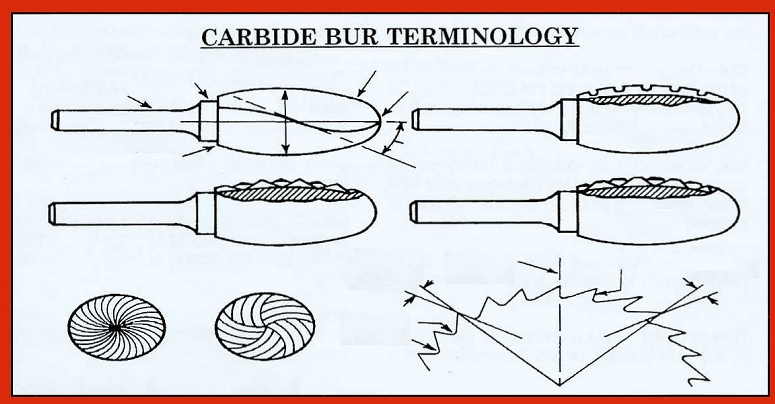
|
|





Apex - The tip or angular summit of the tool, opposite the shank end. Axis - The center line extending thru the shank and head on which the tool rotates. Blank - The material of the tool in a finished or semi-finished state before the teeth have been ground. Braze - The method employed to join two metals by a film silver solder or copper fused at high heat. Bur - A rotary cutting tool having teeth ground onthe circumference and manufactured in various shapes and sizes. Also called a rotary file. Carbide - A man-made metal of extreme hardness, consisting primarily of carburized tungsten with a colbalt binder sintered at high heat. Center Fluting - A fluting arrangement having all of the teeth equally spaced and converging at a common point at the apex of the tool. Chip Breaker - Serrations in the cutting edge of the tooth which prevent formation of long chips. Cut - Designation used to indicate the rotation of the tool, as right hand cut or left hand cut. Also used to describe the tooth spacing, as fine, standard, or coarse cut. Diamond Cut - An additional fluting of opposite hand or spiral with approximately 10% fewer teeth, resulting in a tooth shape or pyramid form. End Cut - Fluting as applied to the plane perpendicular to the axis at the cutting end of the tool. FIllet or Gullet - The curved part at the bottom of the flute (formed by the intersection of the tooth face and the back of the next tooth. Flute - The space between the cutting teeth. Hand Ground - The method of producing cutting teeth on accurately formed blanks by off-hand grinding. Head - The portion of the tool having the cutting teeth. Helix Angle - The angle that the flute makes with the center line. Can be either R.H. or L.H., but is usually R.H. unless otherwise noted. Land - A Section of the tooth reinforcing the cutting edge. It may or may not be relieved. Major Diameter - The largest diameter of the tool. Machine Ground - The method of forming cutting teeth by automated machine grinding Negative Rake - The angle by which the face of the tooth is displaced ahead of the radial line. |
Positive Rake - The angle by which the face of the tooth is displaced behind the radial line. Radial Rake - The condition in which the face of the tooth coincides with the radial line and has no rake angle. Rake - The angle by which the face of the tooth is displaced ahead or behind the radial line drawn from the cutting edge to the center of the rotation. Recondition - The term applied when extensive reworking (including rebrazing, replacing shanks, and removing badly chipped sections) is necessary to restore a used tool to working condition. Resharpen - The term applied to the work necessary to restore a normally worn and dull tool to working condition. Rotary File - A rotary cutting tool having teeth ground on the circumference and manufactured in various shapes and sizes. Also called a bur. Salvage - When extensive reworking (including rebrazing, replacing shanks, and removing badly chipped sections) is necessary to restore a used tool to reworking condition. This process involves totally removing all flutes on the tool and starting with a clean, smooth blank. Then the total reflute process is done to restore exactly as a new tool, but smaller in diameter by approximatley .030 inches. Sectional Fluting - A fluting arrangement having a small portion of the teeth evenly spaced and converging at a common point at the apex of the tool Shank - The portion of the tool which is gripped or chucked by the driver. Shape - The form or profile of the cutting head. Shoulder - An enlarged section of the shank against which the head locates. Spiral Angle - The angle that the flute makes with the center line. Can be either R.H. or L.H., but is usually R.H. unless otherwise noted. Supercut - An additional fluting cut of opposite hand of spiral except with approximately 50% fewer teeth, resulting in a tooth shape of wedge or chisel form. Tooth - Portion of the tool left between the flutes. Tooth Clearance - The amount by which the heel of the land clears the path made by the cutting edge, measured in degrees or indicator drop. Tooth Depth - The distance from the cutting edge to the bottom of the flute. Tooth Face - The part of the tooth that faces the direction or rotation. |
Shank |
Shoulder |
Major Diameter |
Carbide Head |
Apex |
Helix Angle |
Braze |
Axis |
Chipbreaker Cut |
Diamond Cut |
Super Cut |
Center Fluting |
Sectional Fluting |
Flute |
Fillet |
Negative Rake |
Radial Rake |
Tooth Face |
Postive Rake |